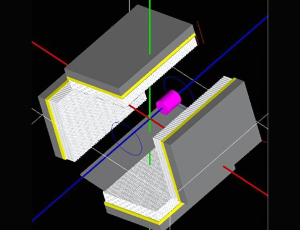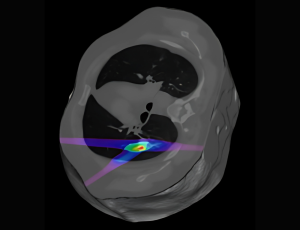At its heart, a Monte Carlo simulation is a powerful computational method that relies on repeated random sampling to obtain numerical results. The name, of course, evokes the glamour of the Monaco casino and the core principle is surprisingly similar: if you roll a die enough times, you can approximate a very complex probability distribution with remarkable accuracy. In medical physics, we trade dice and roulette wheels for particles – photons, electrons and protons – and the “casino” is a virtual model of a patient, a detector or a medical device. By simulating the journey and interactions of billions of these particles, we create a “digital twin” of physical reality, allowing us to understand, predict and optimize medical procedures with a level of detail that is often impossible to achieve experimentally.

Figure 1: Example of a hypothetical four-headed SPECThead system. The detectors are not pixelated in this example.
A Cornerstone of Medical Imaging and Dosimetry
The significance of Monte Carlo simulations in medicine cannot be overstated; they serve as the computational gold standard. In medical imaging, particularly for modalities like PET and SPECT, simulations are indispensable. They allow us to model the entire imaging chain: from the random emission of radiation within a patient, through its journey and potential scattering in tissues, to its final detection in the scanner.
Why is this so crucial? It enables us to optimize scanner design, as companies can test countless virtual prototypes to find the most efficient and effective geometry before a single physical component is built. It also allows us to develop advanced algorithms, since the “ground truth” provided by a simulation is perfect for developing and validating image reconstruction algorithms. For instance, accurately correcting for scattered photons—which would otherwise degrade image quality—heavily relies on insights gained from Monte Carlo models. Finally, it helps us create digital phantoms: incredibly realistic and complex anatomical models that can be used to assess image quality and a technique’s diagnostic power without ever exposing a patient to radiation.
In radiation therapy and dosimetry, the stakes are even higher. The goal is to deliver a lethal dose of radiation to a tumour while sparing surrounding healthy tissue. Monte Carlo simulations provide the most accurate method for calculating the absorbed dose, tracking the energy deposition of each individual particle. This is especially critical in complex situations, like small field dosimetry or when tissues of different densities (like bone and lung) are involved, where simpler models fail.

Figure 2: Dose distribution simulated for a C12 irradiation inside a CT image of a thorax.
Tools of the Trade: A Focus on GATE
The power of Monte Carlo simulation is harnessed through sophisticated software packages. While foundational toolkits like Geant4, MCNP or EGSnrc provide the core physics engines, they often require significant programming expertise. This is where application-specific platforms have become transformative. The GATE platform is a prime example. Developed by a large international collaboration, GATE provides a user-friendly, script-based interface to the powerful Geant4 toolkit. It was specifically designed for the medical physics community, with built-in functionalities for simulating PET, SPECT, CT and radiation therapy. Its accessibility and dedicated focus have made it an incredibly popular tool in both academia and industry, fostering a vibrant global community that contributes to its continuous development.
The latest GATE10 version (end of 2024) came with a brand-new engine: simulations are now described with Python scripting. Installation is a one line “pip install opengate”. It is now multithread, and still open source and open to collaboration. Give it a try!
The Next Frontier: Synergy with Artificial Intelligence (AI)
For all their power, Monte Carlo simulations have a well-known Achilles’ heel: they are computationally expensive. Simulating billions of particles to get a low-noise, high-accuracy result can take hours or even days. This is where the burgeoning field of AI is creating a paradigm shift.
The interaction is a two-way street. On the one hand, AI is accelerating Monte Carlo simulations. Machine learning models, particularly deep neural networks, can be trained to denoise simulation outputs, allowing us to achieve high-quality results from simulations run for only a fraction of the usual time. Furthermore, AI can be used to create “surrogate models” that learn the complex physical behaviour from a full Monte Carlo simulation and can then predict the outcome almost instantaneously.
On the other hand, Monte Carlo methods are fueling AI development. AI algorithms require vast amounts of high-quality, labelled training data—which, in medicine, can be scarce and difficult to acquire. Monte Carlo simulations provide a perfect engine for generating unlimited synthetic data. We can create thousands of virtual patient images with precisely known tumour locations, scatter profiles, or dose distributions, offering the ideal training ground for AI models intended for tasks like automated tumour segmentation or image reconstruction.
Conclusion
Monte Carlo simulation has evolved from a niche academic tool to an essential part of the medical physicist’s virtual sandbox. Its deep integration into scanner design, treatment planning, and algorithm development has fundamentally improved the efficacy and safety of medical procedures. Now, its powerful synergy with AI is opening a new frontier, promising a future of faster, more accurate and highly personalized computational medicine.
References
Gate: https://github.com/OpenGATE/opengate
D. Sarrut, A. Etxebeste, E. Muñoz, N. Krah, and J. M. Létang, “Artificial Intelligence for Monte Carlo Simulation in Medical Physics,” Frontiers in Physics, vol. 9, p. 601, 2021, doi: 10.3389/fphy.2021.738112
Schaffner, B., et al. (2020). The role of artificial intelligence in Monte Carlo-based computational dosimetry. *Physica Medica*, 79, 77-87
D. Sarrut et al., “The OpenGATE ecosystem for Monte Carlo simulation in medical physics,” Phys Med Biol, vol. 67, no. 18, Sep. 2022, doi: 10.1088/1361-6560/ac8c83

